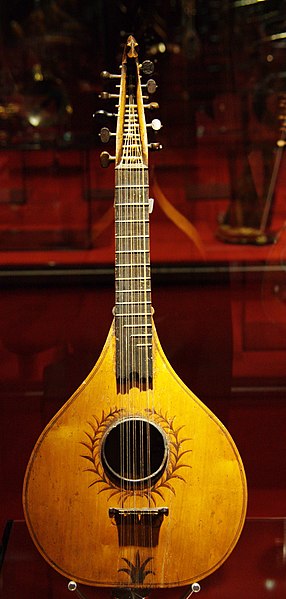The cittern or cithren is a stringed instrument dating from the Renaissance. Modern scholars debate its exact history, but it is generally accepted that it is descended from the Medieval citole. Its flat-back design was simpler and cheaper to construct than the lute. It was also easier to play, smaller, less delicate and more portable. Played by people of all social classes, the cittern was a popular instrument of casual music-making much like the guitar is today.
Cittern exhibited at the Music Museum of Barcelona
Image: Cittern MET DP163302
Image: Sir Joshua Reynolds Portrait of Mrs. Froude
Image: Stringed instruments Musical Instrument Museum, Brussels IMG 3919
The citole was a string musical instrument, closely associated with the medieval fiddles and commonly used from 1200–1350. It was known by other names in various languages: cedra, cetera, cetola, cetula, cistola, citola, citula, citera, chytara, cistole, cithar, cuitole, cythera, cythol, cytiole, cytolys, gytolle, sitole, sytholle, sytole, and zitol. Like the modern guitar, it was manipulated at the neck to get different notes, and picked or strummed with a plectrum. Although it was largely out of use by the late 14th century, the Italians "re-introduced it in modified form" in the 16th century as the cetra, and it may have influenced the development of the guitar as well. It was also a pioneering instrument in England, introducing the populace to necked, plucked instruments, giving people the concepts needed to quickly switch to the newly arriving lutes and gitterns. Two possible descendant instruments are the Portuguese guitar and the Corsican Cetera, both types of cittern.

Citole made c. 1300, exhibited at the British Museum
Italy. Ducal Palace Studiolo Cittern or late citole showing the remains of the citole thumb hole, as a hook on the back of the neck, 1478–1482. Soundholes drilled in soundboard in a circle, with soundboard rose. Two soundholes in side of instrument.
England. British Museum Citole (formerly Warwick Castle Gittern), with three of the holly-leaf points (the shoulders and the trefoil).
A reconstruction of a medieval citole








